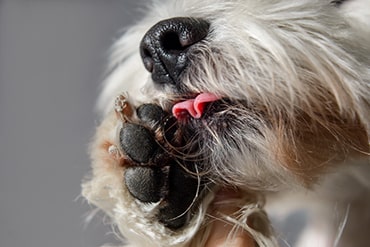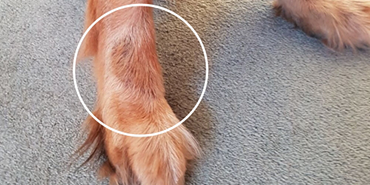Saliva Staining and Overgrooming in Dogs
Overview
- Most of the time dogs develop saliva staining when they lick an area of their body excessively.
- Itchy skin, pain, stress, and boredom are some of the most common causes of saliva staining in dogs.
- Saliva staining can be brown, red, orange or pink.
- It’s common in-between the toes, on the feet/legs, and is most noticeable on white dogs.
What causes saliva staining?
Saliva staining develops when an area of fur is constantly licked, chewed or nibbled, causing it to turn red, pink, brown or orange. It usually indicates an underlying problem such as:
- Allergic skin disease/skin allergies (very common)
- Parasites
- Arthritis
- A wound
- A grass seed
- An interdigital cyst
- Anything else that causes irritated/itchy skin
- Stress and anxiety
- Boredom
Saliva staining can be seen anywhere on the body, but is most common in-between the toes, and on the feet/legs.
Saliva staining around the mouth is slightly different because it’s usually caused by drooling and isn’t often a problem. However, if your dog suddenly develops staining around their mouth when they didn’t used to, you should check their teeth, lips and skin, and contact your vet for advice if you notice anything unusual such as bad breath, a skin problem or dental disease.

This dog has saliva staining around the mouth and in between the toes

This dog has saliva staining on his foot, he has been over-grooming due to arthritis.
Treatment
It’s not advisable to just wipe saliva staining away, instead your dog will need treatment for the underlying cause. Follow the links above for more information on the specific causes.
Tear staining
Tear staining looks very much like saliva staining, but is caused by overflowing tears. In many dogs, tear staining isn’t an issue, but it’s always sensible to have it checked by your vet because it can be a symptom of an underlying problem with the eyes (especially if it’s developed suddenly).
Published: June 2021
Did you find this page useful?
Tell us more
Please note, our vets and nurses are unable to respond to questions via this form. If you are concerned about your pet’s health, please contact your vet directly.
Thank you for your feedback
Want to hear more about PDSA and get pet care tips from our vet experts?
Sign up to our e-newsletter
Written by vets and vet nurses. This advice is for UK pets only. Illustrations by Samantha Elmhurst.

